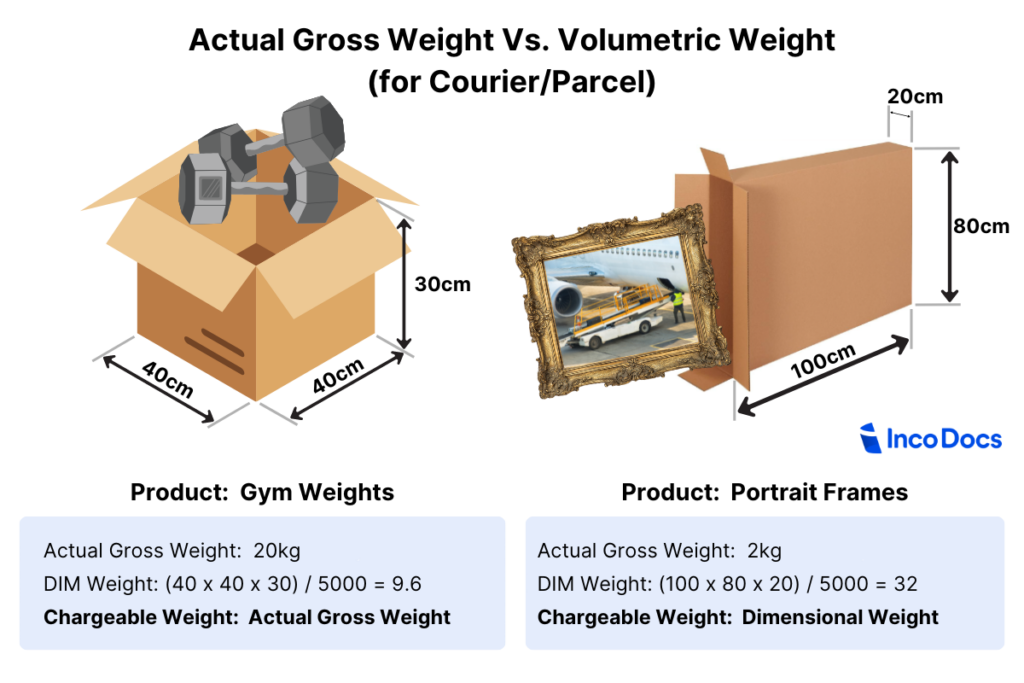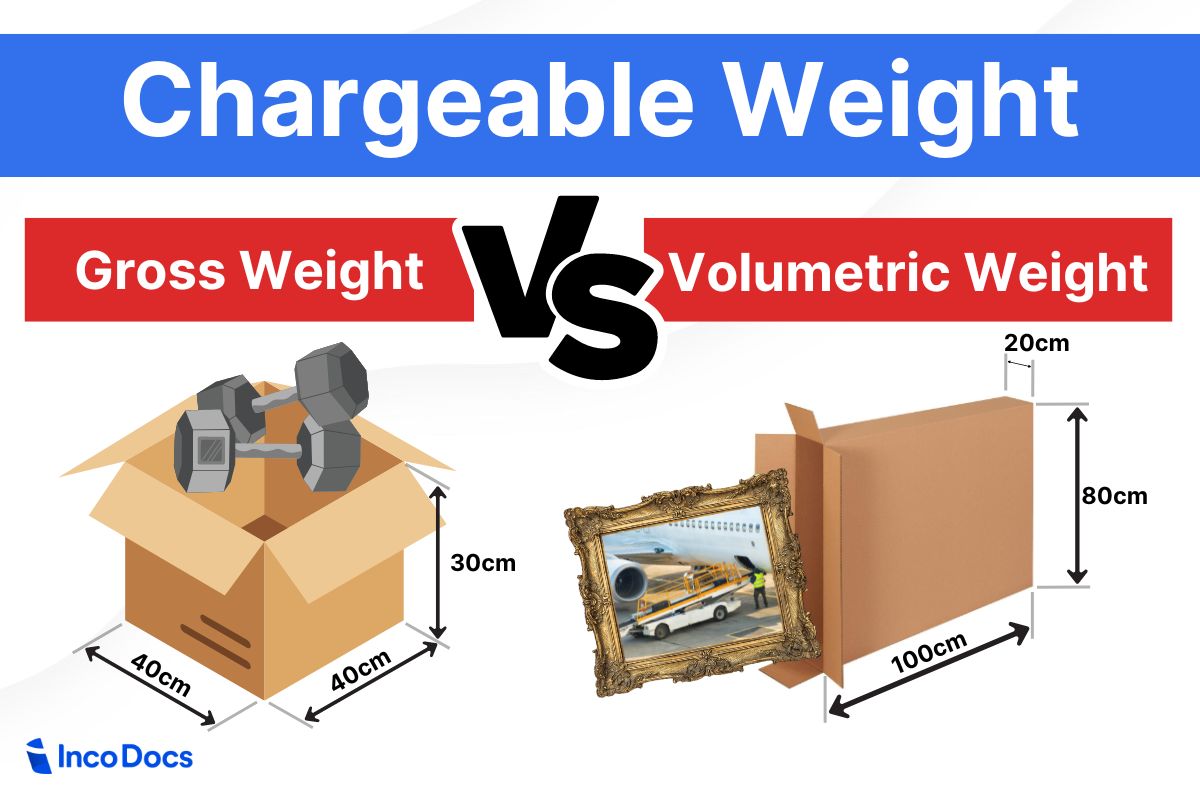Chargeable weight is an abstract quantity that freight carriers use to calculate the total shipping cost. Chargeable Weight is used for the various modes of transport, including Seafreight, Airfreight, Courier/Parcel, Roadfreight and Railfreight shipments. Chargeable Weight can be either the Actual Gross Weight, or the Volumetric Weight of the cargo, whatever is greater.
Volumetric weight (also known as cubed weight) considers the space a shipment occupies, which can often result in higher charges for large, lightweight items. Many shippers face confusion over why they are charged more for shipments that weigh less but take up more space.
This article clarifies how chargeable weight is calculated and why it matters. By understanding this concept, shippers can better anticipate shipping costs and avoid surprises when dealing with large or oddly shaped items that may not be heavy but still incur higher charges due to their size.
Actual Gross Weight vs. Volumetric Weight
Comparison Table for DIM factors, Conversion Rates and Formulas for Different Modes of Transport:
It’s important to note that the DIM factors, conversion rates and formulas vary for the different modes of transport. The differences are as displayed in the table below.
| Mode of Transport | DIM Factor | Conversion Rate (kg per CBM) |
1 CBM to kg | Formula to Calculate Dimensional Weight |
|---|---|---|---|---|
| Sea Freight | 1000 | 1000 | 1 CBM = 1000kg | Length (m) x Width (m) x Height (m) x 1000** |
| Air Freight | 6000 | 167 | 1 CBM = 167kg | Length (cm) x Width (cm) x Height (cm) / 6000 |
| Air Parcel / Courier | 5000 | 200 | 1 CBM = 200kg | Length (cm) x Width (cm) x Height (cm) / 5000 |
| Road Freight LTL | 3000* | 333* | 1 CBM = 333kg | Length (cm) x Width (cm) x Height (cm) / 3000 |
| Rail Freight | 3000* | 333* | 1 CBM = 333kg | Length (cm) x Width (cm) x Height (cm) / 3000 |
Notes:
- The seafreight formula is calculated using dimensions in meters.
- The numbers marked with an asterisk () for DIM factors and conversion rates are common industry standards but can be variable and may vary by region or carrier. Specific carriers or regional regulations might use different values based on their operational requirements. Always verify with your carrier to ensure accurate calculations and compliance with their policies.
- By Road: Conversion Rate 333 is widely used, however this can vary per carrier. Some carriers use 250, some 300, most use 333. Always verify with your carrier to ensure accurate calculations and compliance with their policies.
- Although both ’Airfreight’ and ’Courier/Parcel’ shipments both travel on aircraft, the DIM factors for airfreight (6000) and courier/parcel shipments (5000) are different. This difference arises from several factors, including the nature of the shipments, operational efficiencies, and pricing strategies of the respective services.
How to Calculate CBM for Sea Freight, Air Freight, Courier/Parcel, Road Freight and Rail Freight Shipments
As there are various DIM factors involved with different modes of transport, and different types of Chargeable Weight methods used, we created the free CBM Calculator to help you calculate these key factors, along with calculating the Chargeable Freight Amounts for a particular shipment.

How to Calculate the Chargeable Freight for a Shipment
As mentioned above, to calculate the chargeable freight for a particular shipment, first you have to work out if the shipping cost will be charged based on the Actual Gross Weight, or based on the Volumetric Weight (Dimensional Weight). Let’s look at 2 example shipments as below.

Example 1: When Actual Weight is Greater Than Volumetric Weight
Let’s say that you’re shipping a carton that contains gym weights, and you are shipping it via Air Parcel/Courier shipment using DHL, UPS or FedEx. The freight rate is quoted at $7USD per Kg.
Carton Dimensions: 40cm x 40cm x 30cm. Gross Weight: 20Kg.
- Volumetric Weight (Dimensional Weight): 40 x 40 x 30 / 5000 = 9.6Kg.
- Actual Gross Weight: 20Kg.
Since the Actual Gross Weight is 20Kg, which is greater than the Volumetric Weight of 9.6Kg, the chargeable weight will be calculated using the Actual Gross Weight.
- Chargeable Freight = Freight Rate x Actual Gross Weight
- Chargeable Freight = $7USD x 20Kg = $140USD
Example 2: When Volumetric Weight is Greater Than Actual Weight
Let’s say that you’re shipping a carton that contains a large portrait, and you are shipping it via Air Courier/Parcel shipment using DHL, UPS or FedEx. The freight rate is quoted at $7USD per Kg.
Carton Dimensions: 100cm x 80cm x 20cm. Gross Weight: 2Kg.
- Volumetric Weight (Dimensional Weight): 100 x 80 x 20 / 5000 = 32Kg.
- Actual Gross Weight: 2Kg.
Since the Volumetric Weight is 32Kg, which is greater than the Actual Gross Weight of only 2Kg, the chargeable weight will be calculated using the Volumetric Weight.
- Chargeable Freight = Freight Rate x Volumetric Weight
- Chargeable Freight = $7USD x 32Kg = $224USD
Impact on Shipping Costs
These examples show how calculating the chargeable weight type impacts the shipping costs. When the Gross Weight is higher, the shipping costs are based on that total weight. But when the Volumetric Weight (also called Dimensional Weight) is greater, the shipping costs are calculated using the cubic space that the cargo occupies.
Common Conversion Factors for Shipping
There are some key conversion factors used to convert between metric and imperial measurements that are helpful for calculating Actual Gross Weights, Volumetric Weights, Chargeable Weight types and Chargeable Freight amounts. Accurate conversions help avoid costly errors in transportation and logistics planning. Here are some of the most important ones:
- 1 kilogram (kg) = 2.205 pounds (lbs)
- 1 pound (lb) = 0.4536 kilograms (kg)
- 1 inch = 2.54 centimeters (cm)
- 1 centimeter (cm) = 0.3937 inches
What is Positional Weight?
Positional Weight is a specific weight assigned to special cargo that doesn’t fit standard shipping conditions. It applies when the cargo takes up an entire space or position within a unit load device (ULD), even if it doesn’t weigh much. Positional weight is used when items are too large, oddly shaped, or cannot be stacked with other cargo – for example, a motorcycle or a large piece of equipment may require its own space.
In these cases, the shipping cost is based on the positional weight rather than just the volumetric or actual weight. Sometimes, if the actual weight of the cargo exceeds the minimum positional weight, extra charges may apply. Positional weight ensures that the space taken up by such items is fairly charged, whichever is greater, even if the cargo is light.







